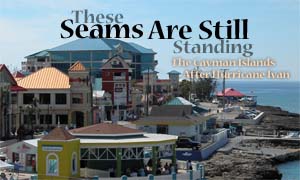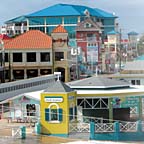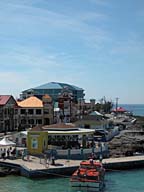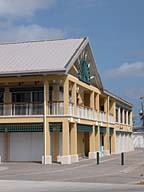These Seams Are Still Standing: The Cayman Islands After Hurricane Ivan

As this article is being written, I have a fine cigar clenched between my teeth, which may or may not have been rolled in the largest island in the West Indies. Chewing on this cigar reminds me of my grandfather, the late Louis Damato.
Louis Damato-known to his friends as Louie and to me as Papa-was a gentle and decent man. I still think of him often, even though it has been over 30 years since his passing. His legacy includes a 60-year marriage to my grandmother that produced six children, dozens of grandchildren, and too many greats to count. Along the way he put in 52 years with the United States Post Office, which began at age 18 and lasted through mandatory retirement at age 70. There is much that I loved and respected about my Papa, but mostly his amazing record of endurance.
Our industry is constantly searching for roofing systems that are cost-efficient, energy-efficient, and perhaps most importantly, roofing systems that will produce an amazing record of endurance.

A Real-world Test
Designing and building roofs that will produce a record of endurance means different things in different climates. One of the toughest climates in the world may be found in the areas of the Atlantic, Gulf and Caribbean, where hurricanes visit in the late summer and early fall of every year. As witnessed in 2004, some years are tougher than others.Hurricane Ivan, in addition to the damage it caused in Georgia, Florida and Alabama, caused considerable death and devastation in the Caribbean, particularly in Grenada, Barbados, Jamaica and the Cayman Islands.
Grand Cayman narrowly missed a direct hit from Ivan, but still had to endure sustained Category 4 winds (on the Saffir-Simpson scale, Category 4 storms have winds from 131-155 mph) and a considerable storm surge. Coming from the south-southeast, the storm peaked for six hours at Category 5 before slamming Grand Cayman, weakened to a Category 4, and regained Category 5 strength as it continued in a north-northwesterly movement toward the panhandle of Florida.
According to a report issued by the National Oceanic and Atmospheric Administration (NOAA) following Hurricane Ivan, it was estimated that 95 percent of the homes and other buildings on Grand Cayman sustained damage or were destroyed. Total damage was estimated at US$1.85 billion ($3 billion including all the affected Caribbean islands, except Cuba).
Owing at least in part to the fact that construction in the Cayman Islands is historically superior to that of most Caribbean islands, the death toll there attributed to Ivan was held to only two. Roofing Contractor reported in a feature story in our February 2004 issue that construction codes on the islands follow the Dade County-South Florida Building Code.
As a follow-up to our report from 2004, Roofing Contractor responded to another invitation from Mr. Bob Watler, owner of Watler's Metal Products, to visit Grand Cayman. This time we were invited to check out the performance of metal roofing after it had endured one of nature's most challenging tests. Our observations are not scientific, and should be considered anecdotal, but they provide some examples of successes and failures. We saw this as a unique opportunity to witness the real-world performance of roofing systems that endured what would equal or exceed some of the toughest laboratory testing in existence.

Durable Roofing for the Tropics
Watler's Metal Products is in the business of installing roofing, gutters, metal railings and other metal construction specialties. Roofing Contractor's February 2004 report detailed the firm's work on the still uncompleted Ritz Carlton Grand Cayman project. Construction of the Ritz has been delayed, but not by Hurricane Ivan. Watler had completed the Johns-Manville UltraGard SR-80 PVC roofing system over polyisocyanurate roof insulation, and was still in the process of finishing the Englert Series 2500 Panel System when Ivan arrived in mid September. Both roofing systems were designed to meet or exceed the tough Florida standards and sustained no significant damage as a result of the storm.It may be trivial, but in this case it is true that a picture is worth a thousand words. The cover photo from our February 2004 issue featured the Kirk Harbour Centre with its distinctive metal roofs. Figure 1 is the photograph taken in December of 2003 and Figure 2 was taken in January 2004. The red roof in the latter photograph is the Englert Series 2500 Panel System that Watler was in the process of installing when we visited in 2003. As you can see, the metal roofing appears to be intact, while the shingle roofs have been replaced. Again, these observations are anecdotal and it should be noted that the shingle roofs were low and no doubt subjected to the effects of rising water from their location directly at the water's edge. The storm surge varied on different parts of the island, but was at least 8 feet and covered much of the surface of the island.
Upon closer inspection of roofing on the Kirk Harbour Centre and other standing-seam metal roofing systems in place, the primary losses occurred on the rake edges and on the hips and ridges. While the vast majority of the metal roofs we saw on the island sustained only minor damage, some were substantially destroyed. In most of those cases there was evidence of structural damage, or damage that was caused or begun by trees or other debris flying through the roof. On nearly every home and building there was some evidence of damage to the gutter and downspout systems. Most were simply gone.
Other types of roofing observed included the traditional "zinc" roofs that have been in place on the island for decades. These are simply corrugated galvanized steel roofs typically coated with aluminum paint. Again, anecdotally, these roofs seemed to fare very, very well. It should be noted that most island homes constructed with zinc roofs are built away from the water's edge. The larger oceanfront and bayfront homes had a wide variety of roofs, including concrete and clay tile, standing seam and other metal roofing systems that simulate tile or shakes. The panelized systems generally fared better than the metal shingle types. Panelized systems, standing seam and otherwise, had mostly peripheral damage with the loss of only one or two panels.
There are a good number of laminated asphalt shingle roofs on the island, mostly of a relatively new vintage. These roofs seemed to hold up better than the three-tab shingle roofs. This could have been a matter of age difference, but where damage was noted on the three-tab roofs, it was almost always more significant. On the laminated shingle jobs, the damage was generally limited to one or two small locations.
Concrete tile, such as that on the Owen Roberts International Airport, sustained a good deal of damage. The airport roof is presently dried-in with ice and water shield. This could be owing to the age of many of the concrete tile roofs that were installed prior to the tougher building codes. These roofs could also have sustained significant damage from flying debris.

Lessons Learned
Learning from the damage to his metal roofs from Ivan, Watler has changed the rake from a "C" closure to a superior detail furnished by Englert. For the hip and ridge detail, he has increased the fastening (rivets or screws) to 6 inches on center. Watler also installs metal soffit and mansard systems, and has now changed his policy to insist on a backing of plywood or cement board. The failure rate on these systems installed on open-spaced sheeting or direct to trusses was considerably greater than with those installed over solid decking.
Watler changed to strictly aluminum for his metal roofing several years back. The galvanized and galvalume panelized roofing had proven unable to resist the rigors of the salt air. While these systems may still be in use, Watler specifies aluminum.
All Hands on Deck
Grand Cayman is a popular tourist destination but it had to go into near total lockdown for nearly three months, closing its borders to tourists. Since Ivan, the main focus for the Caymanian people has been to get their economic engine restarted. To that end, much of the island's main tourist attractions and resorts have been repaired, or soon will be.
Watler's personal home received some minor damage, but it has to wait for now. On the other hand, the office and warehouse of Watler's Metal Products sustained major damage with the loss of a number of vehicles, a computerized folding machine, gutter and metal forming machines, and an office full of equipment and records. These assets have been or soon will be replaced, but it takes a long time when nearly everything must be imported. The government of the islands is providing relief by eliminating duty on key items and modifying customs inspections in some cases. The Cayman government also established The National Recovery Committee to aid in the clean-up and rebuilding process.
Success Story?
All things considered, Watler is very fortunate. His work now speaks for itself, and it tells a pretty good story. But Watler is a native Caymanian and would not have wished this on his homeland. His business is now moving at a nonstop pace to keep up with a workload that has suddenly gone up fivefold. The number of workers on his payroll has doubled, and keeping up seems impossible. Suddenly he has a half-dozen new competitors in his previously small market. But Bob Watler has a lot going for him, most notably being a natural-born roofing contractor, fiercely independent and determined.The Cayman Islands recently celebrated its 500-year anniversary. This is not the first hurricane to land on its shores, and it will not be the last. All things considered, the traditional zinc roofs of the past and panelized metal roofing systems of today fared well this time around. In order for Watler and Grand Cayman to succeed in the face of all this damage, they will need to continue their amazing record of endurance.
Looking for a reprint of this article?
From high-res PDFs to custom plaques, order your copy today!





